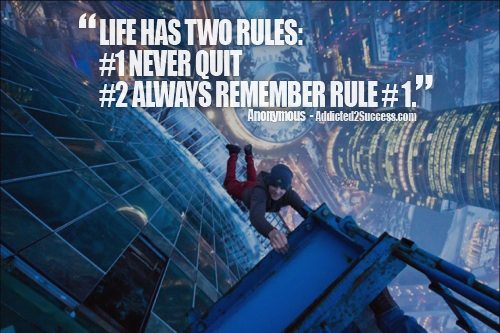Success Advice
Why You Should Duplicate Beliefs To Reach Success

All successful people share similar abilities. They are self-starters, they are able to motivate themselves easily, and they are able to change their thoughts into actions.
To duplicate someone’s success you need to duplicate his or her beliefs. You need the same core beliefs. Beliefs can be the firewall or passage way for you to reach your dreams, negative beliefs stop you from achieving your dreams and positive beliefs aid in the confidence and certainty needed to achieve amazing outcomes. Are you stopping yourself from achieving your dreams because you believe you don’t have the abilities or the resources to get there? Or will you give yourself a chance to say, “I’m going to take a shot, I am going to give this one a crack and prove to myself that I won’t be stopped or limited by my negative beliefs”.
Most people admire their idols so much that they start to believe things like: “They are different than I am, they are superhuman, they are born to do it, I’m not one of the lucky ones”, when that is not true at all. The “pedastooling” needs to stop! If you do this too often then you’ll start to believe that you will NEVER be on their level or be worthy of the success that they have acquired. Learn from your idols, admire them and smile, but don’t EVER believe that you can not be as successful as your role models are because YOU ABSOLUTELY CAN if your desires and beliefs are strong enough to achieve your dreams.
The only thing that is separating you from your idol is the limiting beliefs that you have created for yourself. Your idols may be more fortunate because they have spent the time to learn and master their craft, because they truly love what they do and have put in the long hours behind the scenes, or that they have met the right network of people who can align them with good opportunities along the way, but the one thing that stands them apart from those who have acquired fame and fortune in their field is that they have made the bold commitment to themselves and others, that chasing and achieving their dreams is the only option they have and they will never settle for less. This is the kind of belief that you must enforce in your mind, and your heart, if you want to achieve success with no limits.
Michael Jackson said it best when he said: “We can program ourselves to be the person we want to be, whatever the subject matter is, live in it by a mental physical program – a system of learning and doing. Studying all the greats in that field and becoming greater. I believe we are powerful, but we don’t use our minds to full capacity. Your mind is powerful enough to help you attain whatever you want.”
Also remember, don’t forget to fail, failure breeds success. Don’t think for one minute that your role model or idol never failed at anything at some point in their life. They probably failed more than you know, and that is why they are successful in achieving their dreams.

Personal Development
This Silent Habit Might Be Sabotaging Your Career
Your temper might be costing you more at work than you realize. Here’s why it matters.

You may be the last to know that you’re walking around with a giant chip on your shoulder. Meanwhile, your coworkers are giving you a wide berth. (more…)
Change Your Mindset
The One Leadership Habit That Separates the Great From the Forgettable
True leaders don’t just speak their values, they live them, proving that integrity is the foundation of lasting influence.

Leadership isn’t defined by titles, speeches, or charisma; it’s defined by action. The most respected leaders in history didn’t just preach their values; they lived them. (more…)
Success Advice
Inside the TikTok Resume Hack That’s Fooling Recruiters (For Now)
A viral TikTok resume trick promises interviews overnight, yet one wrong move could blacklist you from future jobs.

Your job hunt has stalled out. After weeks of submitting online applications, you haven’t had a nibble. (more…)
Life
9 Harsh Truths Every Young Man Must Face to Succeed in the Modern World
Before chasing success, every young man needs to face these 9 brutal realities shaping masculinity in the modern world.

Many young men today quietly battle depression, loneliness, and a sense of confusion about who they’re meant to be.
Some blame the lack of deep friendships or romantic relationships. Others feel lost in a digital world that often labels traditional masculinity as “toxic.”
But the truth is this: becoming a man in the modern age takes more than just surviving. It takes resilience, direction, and a willingness to grow even when no one’s watching.
Success doesn’t arrive by accident or luck. It’s built on discipline, sacrifice, and consistency.
Here are 9 harsh truths every young man should know if he wants to thrive, not just survive, in the digital age.
1. Never Use Your Illness as an Excuse
As Dr. Jordan B. Peterson often says, successful people don’t complain; they act.
Your illness, hardship, or struggle shouldn’t define your limits; it should define your motivation. Rest when you must, but always get back up and keep building your dreams. Motivation doesn’t appear magically. It comes after you take action.
Here are five key lessons I’ve learned from Dr. Peterson:
-
Learn to write clearly; clarity of thought makes you dangerous.
-
Read quality literature in your free time.
-
Nurture a strong relationship with your family.
-
Share your ideas publicly; your voice matters.
-
Become a “monster”, powerful, but disciplined enough to control it.
The best leaders and thinkers are grounded. They welcome criticism, adapt quickly, and keep moving forward no matter what.
2. You Can’t Please Everyone And That’s Okay
You don’t need a crowd of people to feel fulfilled. You need a few friends who genuinely accept you for who you are.
If your circle doesn’t bring out your best, it’s okay to walk away. Solitude can be a powerful teacher. It gives you space to understand what you truly want from life. Remember, successful men aren’t people-pleasers; they’re purpose-driven.
3. You Can Control the Process, Not the Outcome
Especially in creative work, writing, business, or content creation, you control effort, not results.
You might publish two articles a day, but you can’t dictate which one will go viral. Focus on mastery, not metrics. Many great writers toiled for years in obscurity before anyone noticed them. Rejection, criticism, and indifference are all part of the path.
The best creators focus on storytelling, not applause.
4. Rejection Is Never Personal
Rejection doesn’t mean you’re unworthy. It simply means your offer, idea, or timing didn’t align.
Every successful person has faced rejection repeatedly. What separates them is persistence and perspective. They see rejection as feedback, not failure. The faster you learn that truth, the faster you’ll grow.
5. Women Value Comfort and Security
Understanding women requires maturity and empathy.
Through books, lectures, and personal growth, I’ve learned that most women desire a man who is grounded, intelligent, confident, emotionally stable, and consistent. Some want humor, others intellect, but nearly all want to feel safe and supported.
Instead of chasing attention, work on self-improvement. Build competence and confidence, and the rest will follow naturally.
6. There’s No Such Thing as Failure, Only Lessons
A powerful lesson from Neuro-Linguistic Programming: failure only exists when you stop trying.
Every mistake brings data. Every setback builds wisdom. The most successful men aren’t fearless. They’ve simply learned to act despite fear.
Be proud of your scars. They’re proof you were brave enough to try.
7. Public Speaking Is an Art Form
Public speaking is one of the most valuable and underrated skills a man can master.
It’s not about perfection; it’s about connection. The best speakers tell stories, inspire confidence, and make people feel seen. They research deeply, speak honestly, and practice relentlessly.
If you can speak well, you can lead, sell, teach, and inspire. Start small, practice at work, in class, or even in front of a mirror, and watch your confidence skyrocket.
8. Teaching Is Leadership in Disguise
Great teachers are not just knowledgeable. They’re brave, compassionate, and disciplined.
Teaching forces you to articulate what you know, and in doing so, you master it at a deeper level. Whether you’re mentoring a peer, leading a team, or sharing insights online, teaching refines your purpose.
Lifelong learners become lifelong leaders.
9. Study Human Nature to Achieve Your Dreams
One of the toughest lessons to accept: most people are self-interested.
That’s not cynicism, it’s human nature. Understanding this helps you navigate relationships, business, and communication more effectively.
Everyone has a darker side, but successful people learn to channel theirs productively into discipline, creativity, and drive.
Psychology isn’t just theory; it’s a toolkit. Learn how people think, act, and decide, and you’ll know how to lead them, influence them, and even understand yourself better.
Final Thoughts
The digital age offers endless opportunities, but only to those who are willing to take responsibility, confront discomfort, and keep improving.
Becoming a man today means embracing the hard truths most avoid.
Because at the end of the day, success isn’t about luck. It’s about who you become when life tests you the most.
-

 Business4 weeks ago
Business4 weeks agoThinking of Buying A Business? These 6 Sectors Quietly Produce the Best Deals
-

 Change Your Mindset3 weeks ago
Change Your Mindset3 weeks agoWork-Life Balance Isn’t a Myth: Here’s How to Actually Make It Happen
-

 Change Your Mindset3 weeks ago
Change Your Mindset3 weeks agoThe Four Types of Happiness: Which One Are You Living In?
-

 Life2 weeks ago
Life2 weeks ago9 Harsh Truths Every Young Man Must Face to Succeed in the Modern World
-

 Success Advice2 weeks ago
Success Advice2 weeks agoInside the TikTok Resume Hack That’s Fooling Recruiters (For Now)
-

 Change Your Mindset1 week ago
Change Your Mindset1 week agoThe One Leadership Habit That Separates the Great From the Forgettable
-

 Personal Development5 days ago
Personal Development5 days agoThis Silent Habit Might Be Sabotaging Your Career
-

 Business2 days ago
Business2 days agoWhy Your E-Commerce Fulfilment Is Probably Broken (And How to Fix It)

























6 Comments